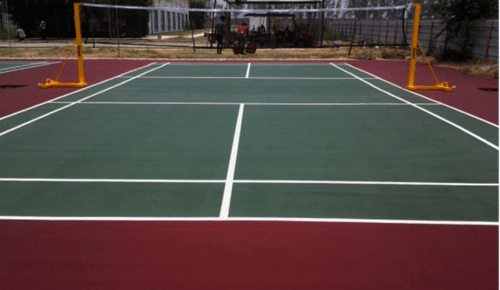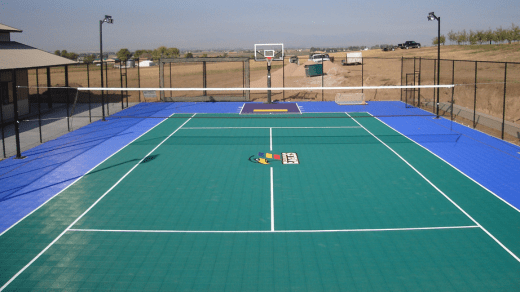As outdoor sports gain more prominence in India’s urban and semi-urban settings, volleyball is becoming a top choice for schools, parks, clubs, and residential communities. Known for its energy, pace, and full-body engagement, volleyball court flooring demands a court surface that is tough, slip-resistant, and resilient in all weather conditions. That’s where acrylic flooring is making a significant impact. Engineered for outdoor use and built with advanced synthetic flooring materials, this surface offers unmatched performance, durability, and low maintenance—making it the most reliable choice for outdoor volleyball courts.
Why Traditional Surfaces Are No Longer Enough
Historically, outdoor volleyball court flooring in India have been made from bare concrete, interlocking tiles, or even dirt and grass. While these surfaces may be inexpensive initially, they often compromise player safety and game performance. Uneven surfaces can lead to unpredictable ball bounce, poor grip, and an increased risk of injuries. Concrete courts, in particular, are hard on joints, causing long-term strain on players.
The rise of modern sports infrastructure has introduced synthetic court systems as a better alternative. Among these, acrylic flooring stands out for its excellent balance of grip, shock absorption, and weather resistance—all essential for volleyball, where explosive movements and rapid footwork are constant.
Understanding Acrylic Flooring: A Layered System for Superior Play
Acrylic volleyball courts are built as layered systems using synthetic flooring materials applied over a solid synthetic ground, typically concrete or asphalt. The process begins with base preparation, where the surface is leveled and primed. Next, layers of acrylic coatings mixed with silica sand are applied for texture and traction. These layers are colored using acrylic floor paint to create vibrant, UV-resistant surfaces. Finally, the entire system is sealed with a durable acrylic floor finish that protects the court from environmental damage and daily wear.
This engineered surface ensures consistent bounce, excellent foot grip, and reduced stress on knees and ankles. The result is a floor court that feels professional, performs well in all weather, and retains its quality for years.
Weather Resistance: Built for India’s Harsh Outdoor Conditions
One of the biggest advantages of acrylic volleyball courts is their ability to withstand extreme Indian weather. From scorching summer heat to monsoon rains, outdoor courts face constant exposure to UV rays, moisture, and temperature fluctuations. Traditional concrete or tiled courts quickly degrade in such conditions—fading, cracking, or becoming dangerously slippery.
Acrylic floors, on the other hand, are designed to resist these challenges. The acrylic floor finish forms a sealed, non-porous barrier that repels water, reduces heat absorption, and prevents surface deterioration. Even after a rainstorm, an acrylic sport court dries quickly, allowing games to resume with minimal delay. This makes it an ideal choice for schools, clubs, and public parks where court downtime must be kept to a minimum.
Player Safety and Comfort
Volleyball is a sport that involves frequent jumping, quick lateral movements, and constant player-to-surface interaction. Safety is paramount, and the surface plays a key role in preventing slips, falls, and impact injuries. Acrylic flooring offers a slip-resistant texture that enhances player stability during sudden movements. This is especially important on outdoor courts where dust, rain, or humidity can otherwise create hazardous conditions.
Additionally, cushioned acrylic systems can be used to enhance shock absorption. These systems include rubberized base layers below the acrylic floor paint, providing a soft landing that reduces joint stress. Whether it’s a weekend game between friends or a rigorous training session, players benefit from the comfort and support offered by well-designed synthetic flooring.
Design Flexibility with Acrylic Court Paint
Acrylic systems allow for complete customization of your volleyball court using specialized court paint. Court lines, zones, logos, and color schemes can all be added with precision. Popular color combinations like green and red, blue and grey, or orange and black help improve visibility for players while enhancing the overall look of the court.
Because acrylic floor paint is UV-stable, colors don’t fade easily—even under intense sun exposure. Courts look vibrant and professional for years, making them not just functional, but also attractive additions to any recreational space or sports complex.
Low Maintenance and Long-Term Value
One of the reasons why more developers and sports facility managers are choosing acrylic flooring is its low maintenance requirements. Unlike interlocking tiles that loosen over time or turf that requires grooming and infill replacement, acrylic floors are simple to maintain. Regular cleaning with water, occasional sweeping, and an easy topcoat refresh every 7–10 years is typically all that’s needed.
This ease of maintenance significantly reduces operational costs over time. Moreover, because synthetic flooring materials used in acrylic systems are highly durable, the surface remains playable even after years of high-traffic use. That long-term performance makes acrylic courts a smart investment for institutions, schools, and municipalities aiming for lasting value.
Multi-Sport Compatibility
Many outdoor volleyball courts today are part of multi-purpose sport court complexes. One of the biggest advantages of using acrylic flooring is that it can easily be adapted for use across multiple sports. With different line markings using court paint, a volleyball court can double as a basketball, badminton, or futsal area. This adaptability makes acrylic systems even more cost-effective, especially for space-constrained urban developments.
Acrylic Flooring in Schools, Clubs, and Smart Cities
Across India, more schools are turning to acrylic floor systems for outdoor sports facilities. Acrylic courts provide students with safe, visually appealing, and easy-to-maintain playing surfaces that encourage active participation. Similarly, private clubs and residential communities are investing in synthetic court solutions that enhance their amenities and boost member engagement.
In smart cities and urban redevelopment zones, the trend is even more pronounced. Government bodies and city planners now prefer surfaces that are multi-use, durable, and climate-resilient. Acrylic floors tick all these boxes, making them a foundational element in the creation of next-gen outdoor recreational spaces.
Conclusion
As volleyball continues to grow in popularity across India, especially in open-air environments, the need for high-quality, long-lasting court surfaces is more important than ever. Acrylic flooring offers a perfect blend of safety, durability, performance, and aesthetics—making it the top choice for outdoor volleyball courts.
From the sturdy synthetic ground to the textured layers of acrylic floor paint, every component of this flooring system is designed to enhance the game and protect the players. With minimal upkeep, vibrant colors, and all-weather usability, acrylic sport courts represent the future of outdoor volleyball infrastructure in India.




